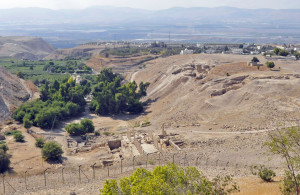
Ruins of Pella, overlooking Jordan River Valley (Photo by Don Knebel)
About 10,000 years ago, Stone Age farmers established a permanent village in the fertile lands in the eastern foothills of the Jordan River Valley. By 1800 B.C., the village had become a city called “Pihilum,” featuring an important Canaanite temple. The Greeks captured Pihilum in the third century B.C. and renamed it “Pella,” honoring the birthplace of Alexander the Great. When the Romans captured the area in 63 B.C., they made Pella one of the ten self-governing cities of the Decapolis, adding the temples, theaters, baths and colonnaded streets typical of major Roman cities.
In 70 A.D., four Roman legions sent to Jerusalem to put down the First Jewish Revolt entered the city after an extended siege, killed up to a million residents and demolished the Second Temple. In the fourth century, Eusebius and other historians reported that Christian inhabitants of Jerusalem had been warned of the impending devastation by a “revelation” and escaped to Pella, about 50 miles northeast. Many scholars associate this account with the statements of Jesus, reported in the Gospel of Luke, predicting the destruction of the Temple and warning his followers to “flee to the mountains” when they see “Jerusalem being surrounded by armies.” Despite the first century context of Jesus’ statements, some believe they presage events at the end of time and await their own cues to flee to the mountains.
Pella was destroyed by an earthquake in 749 and its history largely forgotten. But the story of the early Christians’ flight to Pella was remembered by 800 freedom-seeking Dutch immigrants who settled in Southern Iowa in 1847 and named their new town after that ancient refuge.
Comments are closed.